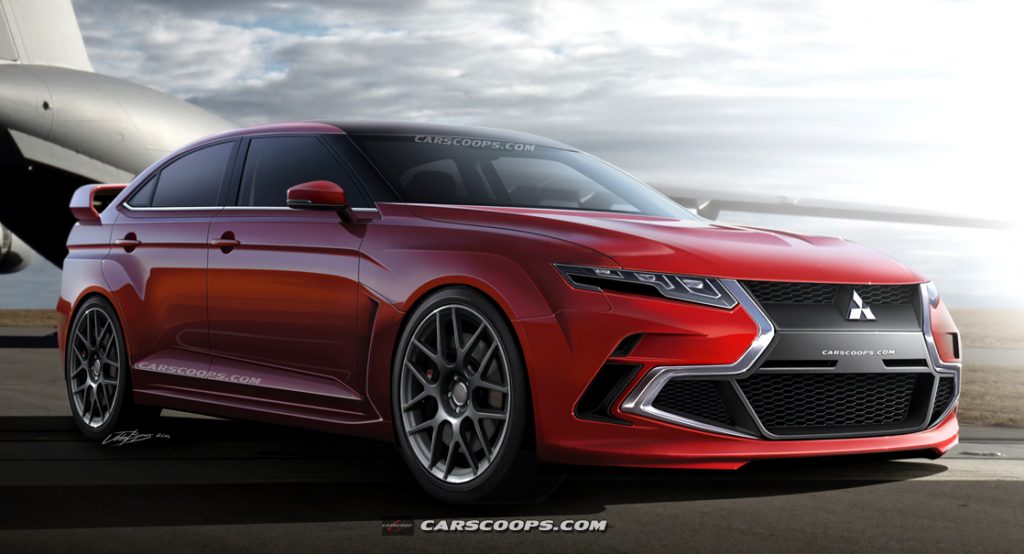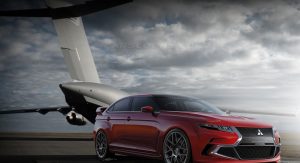Mitsubishi’s Lancer Evolution is what you would consider as an affordable, all-wheel-drive, four-door rally car with a slingshot demeanor. Today, it’s arguably still a poster child for many youths and enthusiasts who identify with the Fast & Furious scene.
However, like the current Lancer, the Evolution X is getting rather long in the tooth. Word is that the Japanese carmaker is planning on developing a successor to the current variant. So with that in mind, it was decided to speculatively render how a future Evo could look.
Design:
While the design of the current Evo X looks handsome, it suffers from a rather conservative body. This proposal adopts Mitsubishi’s upcoming bold new design language, with an aim of making it crisp, taut and masculine – whilst retaining a dose of Japanese character.
Beginning at the potent end; the honeycomb grille is framed by satin-chrome elements that zig-zag down into the bumper like a set of spiders legs. On either side you will find inlets for brake cooling, while narrow cut-outs within the headlights aid cold-air induction.
Above the LED headlights, sits an aluminium hood that pays homage to Evo’s of old with their twin-flared vents. Further down, angular front fenders provide room for a wider track whilst emphasizing an aggressive stance.
From the side, sharp creases dominate as they sweep backwards along the doors. The front fender vents in particular mimic the grille, before merging into the lower side skirts. For a point of difference, the glasshouse has a wrap-around windscreen in a fashion not too dissimilar to Mitsubishi’s own XR-PHEV Concept.
At the hind quarters, angular lines echo those found at the front; they flow down from the taillights, forming part of the trunk-lid before encompassing the flared lower fender vents. This unique graphic is reinforced with quad exhaust tips and an large rear spoiler for visual punch.
Performance & Handling:
Speculation is rife about a performance hybrid being developed for the Evolution X’s successor. For the performance minded amongst us, taking this avenue can yield great benefits – so don’t panic, as it certainly won’t be a Prius clone.
Just look at what Porsche, McLaren and Ferrari have achieved with their 918, P1 and LaFerrari hybrid supercars, not only do their electric-assist systems help with fuel economy, but they also offer massive low-end torque advantages that stand-alone internal combustion engines struggle to emulate.
For this study, I envisage a similar direction as initiated from Mitsubishi’s recent XR-PHEV Concept – by employing a turbo-charged, direct injection 2.0-litre four, mated to electric motors positioned at the front and rear.
Making most of this extra eco-friendly oomph is a fine-tuned version of Mitsubishi’s Super All-Wheel Control (S-AWC) AWD system. Utilising electric motors to adjust torque and power at each wheel, this could provide enhanced levels of grip over what a standard all-wheel drive system already offers.
A hallmark of the Evolution series is their ability to dart from corner to corner over back-country roads; great for when you’re in the mood, but the firm suspension can become tiresome in day-to-day commuting. Achieving a better-balanced ride could be gained by using adaptive magnetic damping with sensors that scan the road ahead for surface irregularities – similar to what Mercedes-Benz’s ‘magic ride control’ feature offers.
Overall, this design proposition takes on a contemporary new direction for the Lancer Evolution; its plug-in hybrid platform could introduce an exciting new era for affordable, fuel-efficient, sports sedans. Expect Mitsubishi to drop more news about the next Evolution in the near future – and who knows, it may just sport an entirely new name.
Tell us you feedback in the discussion area below.
By Josh Byrnes
Photo Renderings Copyright: Carscoops / Josh Byrnes
PHOTO GALLERY









